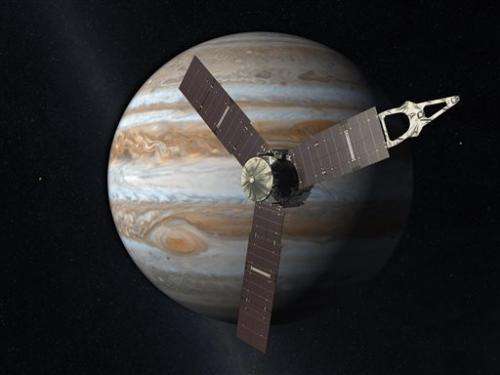Bye Earth: NASA spacecraft barrels toward Jupiter (Update)

NASA's Juno spacecraft whipped around Earth on Wednesday, using our home planet as a gravity slingshot to fling itself toward Jupiter.
Snapping pictures during the swing past Earth, Juno hurtled 350 miles (560 billion kilometers) above the ocean off the coast of South Africa, the point of closest encounter.
Previous missions to the outer solar system have used Earth as a celestial springboard since there's no rocket powerful enough to make a direct flight. The Galileo spacecraft buzzed by Earth twice in the 1990s en route to Jupiter, the solar system's largest planet located 484 million miles (780 million kilometers) from the sun.
Launched in 2011, Juno flew beyond the orbit of Mars before looping back toward Earth for a quick visit. Wednesday's flyby boosted Juno's speed from 78,000 mph relative to the sun to 87,000 mph (140,000 kph)— enough momentum to cruise past the asteroid belt to Jupiter, where it should arrive in 2016.
NASA and the European Space Agency said ground controllers in Australia and Spain picked up a signal from the spacecraft shortly after the pass. But engineers were puzzled by the low data rate and were investigating.
During the maneuver, the solar-powered, windmill-shaped Juno briefly slipped into Earth's shadow and emerged over India's east coast. At closest approach, Juno passed over the coast of South Africa where NASA said skywatchers with binoculars or a small telescope may see it streak across the sky, weather permitting. Ham radio operators around the globe were encouraged to say "Hi" in Morse code—a message that may be detected by Juno's radio.
By space mission standards, Juno's Earth rendezvous was low-key compared with the Curiosity rover's nail-biting landing on Mars last year, mainly because such flybys have been executed before.
Despite a government shutdown that has prevented NASA from updating its website or tweeting, the space agency's missions continue to operate. Earlier this week, NASA's newest spacecraft, LADEE, slipped into orbit around the moon.
Since the 1970s, spacecraft have circled or flown past Jupiter including the Voyagers, Pioneers, Galileo, Ulysses, Cassini and, most recently, the New Horizons barreling toward Pluto. Missions have beamed back stunning views of Jupiter's trademark Great Red Spot, a raging hurricane-like storm, and its many moons.
Juno promises to inch closer to Jupiter than previous spacecraft, orbiting the planet for at least a year and studying its cloud-covered atmosphere and mysterious interior to better understand how the giant planet formed.
Juno was scheduled to arrive at Jupiter on July 4, 2016, after journeying 1.7 billion miles (2.74 billion kilometers).
© 2013 The Associated Press. All rights reserved.



















